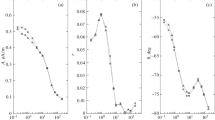A significant difference was found in the amplitude and polarization spectra of ULF magnetic noise at stations with a base of 120 km during periods of absence of regional thunderstorm activity. A simultaneous analysis of low-frequency data and ionosonde data allowed us to conclude that the difference in the main parameters of the polarization spectrum at two stations is due to the appearance of sporadic Es layers having a nonuniform horizontal intensity distribution with characteristic scales of the order of the base between stations. A difference in the depth of variations in the polarization parameter ε was also found during the ionosphere recovery after magnetic storms. It could be related with Es layers, which had not only a nonuniform intensity distribution, but were also located at different altitudes. A difference was found in the frequency scales of the spectral resonance structure during recording of time variations of its fundamental frequencies. Numerical calculations of the parameter ε with specifying model Es layers and electron-density profiles corrected at the altitudes of the ionospheric F layer adequately explained the observed difference in the magnetic noise spectra and allowed us to determine the altitudes at which the horizontal ionospheric irregularity existed. The studies were carried out on the basis of records of horizontal magnetic components at Radiophysical Research Institute midlatitude observatories Novaya Zhizn (56° N, 45.74° E) and Staraya Pustyn (55.66° N, 43.63° E, 120 km east of the first reception point).
Similar content being viewed by others
References
S.V.Polyakov, B. I. Reznikov, Yu.V. Shlyugaev, and Yu.A. Kopytenko, Radiophys. Quantum Electron., 49, No. 12, 937 (2006).
S.V.Polyakov, A.V. Shchennikov, and Z. Tang, Radiophys. Quantum Electron., 57, No. 7, 498 (2014).
P.P. Belyaev, S.V. Polyakov, V.O. Rapoport, and V.Yu.Trakhtengerts, Sov. Phys. Dokl., 32, 983 (1987).
P.P. Belyaev, S.V. Polyakov, V.O. Rapoport, and V.Yu.Trakhtengerts, Radiophys. Quantum Electron., 32, No. 7, 594 (1989).
T. Bösinger, C. Haldoupis, P.P. Belyaev, et al., J. Geophys. Res. A, 107, No. 10, 1281 (2002).
E. N. Ermakova, S.V.Polyakov, and N.V. Semenova, Radiophys. Quantum Electron., 54, No. 12, 796 (2011).
P. P. Belyaev, S.V. Polyakov, E.N. Ermakova, et al., Radiophys. Quantum Electron., 45, No. 2, 135 (2002).
E. N. Ermakova, D. S. Kotik, S.V.Polyakov, and A.V. Shchennikov, Radiophys. Quantum Electron., 50, No. 7, 555 (2007).
J. E. Titheridge, J. Atmos. Sol. Terr. Phys., 65, No. 9, 1035 (2003).
E. N. Ermakova, D. S. Kotik, A.V.Pershin, et al., Radiophys. Quantum Electron., 55, Nos. 10–11, 605 (2012).
E. N. Ermakova, D. S. Kotik, A.V.Ryabov, and A.A.Panyutin, Radiophys. Quantum Electron., 57, No. 11, 782 (2014).
T. Bösinger and S. L. Shalimov, Ann. Geophysicae, 22, 1 (2004).
T. Bösinger, A. G. Demekhov, E. N. Ermakova, et al., J. Geophys. Res. Space Phys., 119, No. 5, 4109 (2014).
E. N. Ermakova, D. S. Kotik, A.V.Pershin, et al., Radiophys. Quantum Electron., 59, No. 12, 947 (2016).
E. N. Ermakova, D. S. Kotik, and S. V. Polyakov, Radiophys. Quantum Electron., 51, No. 7, 519 (2008).
T. Bösinger, E. N. Ermakova, C. Haldoupis, and D. S. Kotik, Ann. Geophysicae, 27, 1313 (2009).
V. V. Kirillov and V. N. Kopeikin, Radiophys. Quantum Electron., 46, No. 1, 1 (2003).
https://ccmc.gsfc.nasa.gov/modelweb/models/iri2016 vitmo.php .
E. Fedorov, N. Mazur, V. Pilipenko, and L. Baddeley, J. Geophys. Res. Space Phys., 121, No. 11, 11282 (2016).
Author information
Authors and Affiliations
Corresponding author
Additional information
Translated from Izvestiya Vysshikh Uchebnykh Zavedenii, Radiofizika, Vol. 62, No. 5, pp. 349–365, May 2019.
Rights and permissions
About this article
Cite this article
Ermakova, E.N., Pershin, A.V., Ryabov, A.V. et al. Influence of Horizontal Ionosphere Nonuniformity on the Spatial Distribution of Ultralow-Frequency Magnetic Fields from Ground-Based Sources. Radiophys Quantum El 62, 311–325 (2019). https://doi.org/10.1007/s11141-019-09979-6
Received:
Accepted:
Published:
Issue Date:
DOI: https://doi.org/10.1007/s11141-019-09979-6



